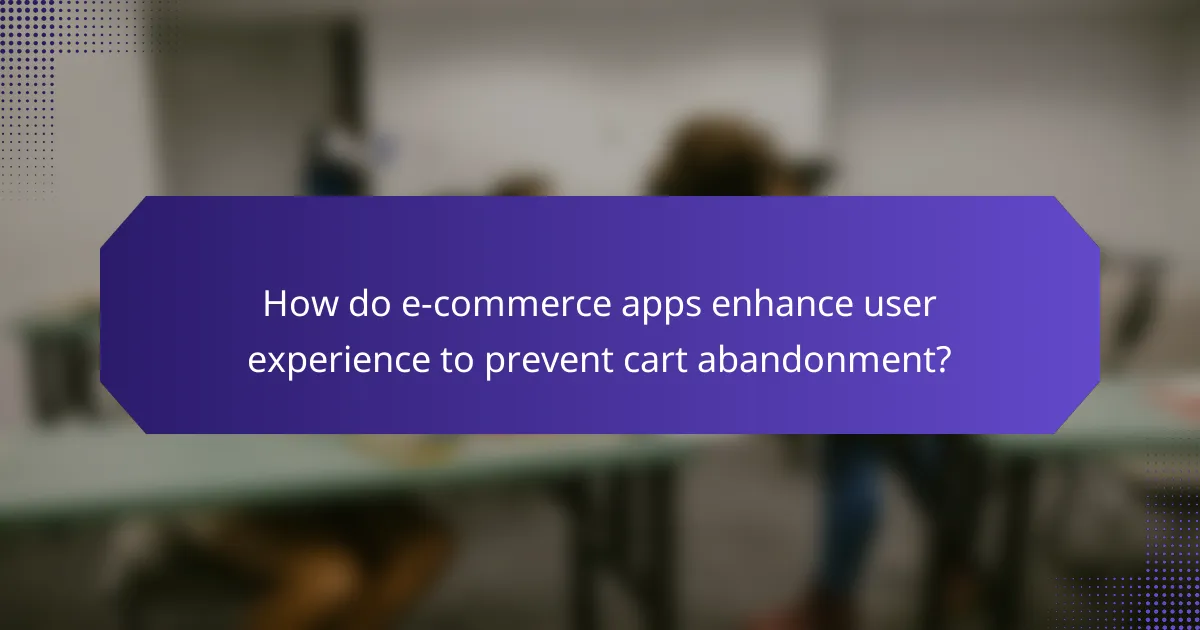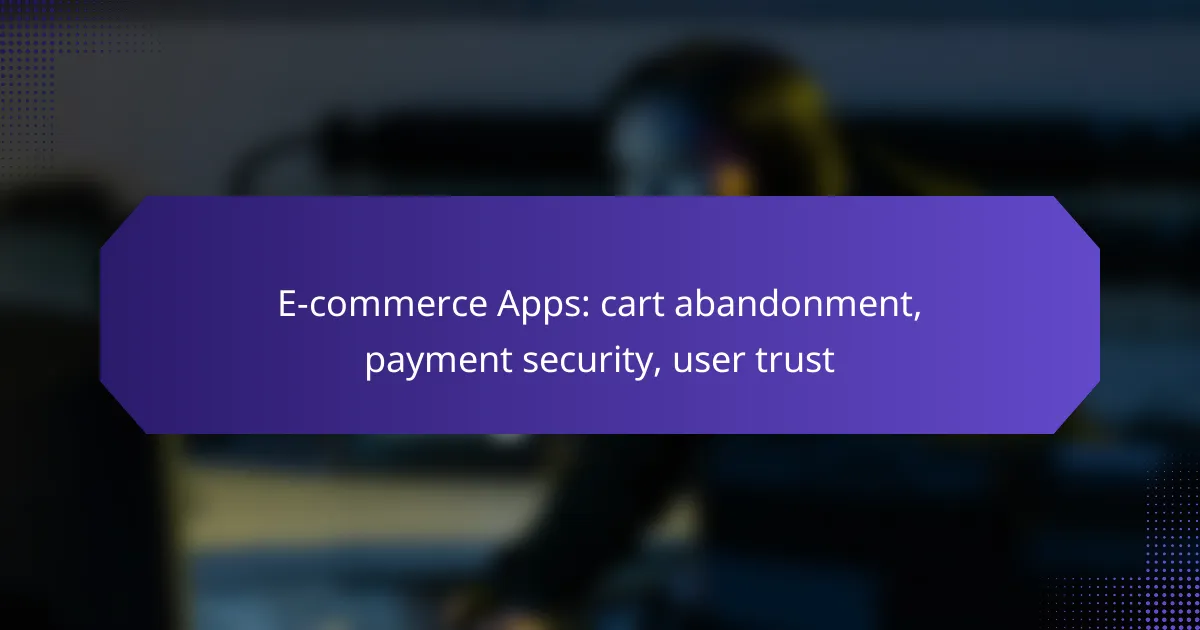E-commerce apps play a crucial role in enhancing the online shopping experience by addressing key challenges such as cart abandonment, payment security, and user trust. By implementing strategies like exit-intent popups and robust security measures, these platforms can engage users effectively and safeguard their data. Building user trust through transparency and reliable support further solidifies the relationship between consumers and e-commerce applications.

How can e-commerce apps reduce cart abandonment in the UK?
E-commerce apps can effectively reduce cart abandonment in the UK by implementing strategies that engage users and streamline their purchasing experience. Key tactics include utilizing exit-intent popups, offering time-limited discounts, and enhancing the overall mobile user experience.
Implementing exit-intent popups
Exit-intent popups can capture users’ attention just as they are about to leave the site. These popups can offer incentives such as discounts or free shipping to encourage users to complete their purchases. Timing and design are crucial; ensure that the popup is visually appealing and appears at the right moment to maximize effectiveness.
Consider A/B testing different messages and offers to see which resonates best with your audience. A well-crafted exit-intent popup can significantly decrease abandonment rates by reminding users of what they are leaving behind.
Offering time-limited discounts
Time-limited discounts create a sense of urgency that can motivate users to finalize their purchases. For instance, offering a 10% discount that expires within a few hours can prompt quicker decision-making. This tactic leverages the fear of missing out (FOMO), which can be particularly effective in driving conversions.
Make sure the discount is clearly communicated during the checkout process. Highlighting the countdown timer can further enhance the urgency and encourage users to act before the offer expires.
Streamlining the checkout process
A streamlined checkout process is essential for reducing cart abandonment. Simplifying forms, minimizing the number of steps, and offering guest checkout options can significantly enhance user experience. Aim for a checkout process that takes no longer than a few minutes to complete.
Consider integrating popular payment methods such as PayPal or Apple Pay, as these can speed up transactions and cater to user preferences. Regularly review and optimize the checkout flow based on user feedback to identify and eliminate any friction points.
Using retargeting ads
Retargeting ads can effectively bring back users who have abandoned their carts. By displaying personalized ads on social media or other websites, you can remind users of the products they left behind and encourage them to return. This strategy keeps your brand top-of-mind and can lead to increased conversions.
Utilize dynamic retargeting to show users the exact items they viewed, along with any special offers. This personalized approach can significantly enhance the chances of converting previous visitors into paying customers.
Enhancing mobile user experience
With a growing number of consumers shopping via mobile devices, enhancing the mobile user experience is crucial for reducing cart abandonment. Ensure that your app is optimized for mobile use, with fast loading times and a responsive design that adapts to various screen sizes.
Focus on simplifying navigation and making buttons easily clickable. A seamless mobile experience can lead to higher engagement and lower abandonment rates, as users are more likely to complete their purchases when they can do so effortlessly on their devices.

What payment security measures should e-commerce apps adopt?
E-commerce apps should implement robust payment security measures to protect user data and enhance trust. Key strategies include utilizing SSL certificates, implementing two-factor authentication, adopting PCI DSS compliance, and integrating secure payment gateways.
Utilizing SSL certificates
SSL certificates encrypt data transmitted between users and the e-commerce app, ensuring that sensitive information remains secure. This encryption helps prevent data breaches and builds customer confidence in the platform.
To implement SSL, choose a reputable certificate authority and ensure that your website uses HTTPS. Regularly update and renew your SSL certificates to maintain security standards.
Implementing two-factor authentication
Two-factor authentication (2FA) adds an extra layer of security by requiring users to provide two forms of identification before accessing their accounts. This can significantly reduce the risk of unauthorized access.
Consider using SMS codes, authentication apps, or email verification as the second factor. Make sure to educate users on how to set up and use 2FA effectively to enhance their account security.
Adopting PCI DSS compliance
Adhering to the Payment Card Industry Data Security Standard (PCI DSS) is essential for any e-commerce app handling credit card transactions. Compliance ensures that your app meets security requirements to protect cardholder data.
To achieve PCI DSS compliance, conduct regular security assessments, implement strong access control measures, and maintain a secure network. Non-compliance can lead to hefty fines and loss of customer trust.
Integrating secure payment gateways like PayPal
Using secure payment gateways such as PayPal can enhance transaction security and user trust. These gateways offer built-in fraud protection and secure payment processing, reducing the burden on your app to manage sensitive data.
When integrating a payment gateway, ensure that it complies with relevant security standards and provides a seamless user experience. Regularly review transaction processes to identify and mitigate potential security risks.

How do e-commerce apps build user trust in the UK?
E-commerce apps in the UK build user trust through transparent practices, reliable support, and visible security measures. By focusing on customer feedback, clear policies, and safety assurances, these platforms create a trustworthy shopping environment.
Displaying customer reviews and ratings
Customer reviews and ratings are essential for building trust in e-commerce apps. They provide potential buyers with insights into product quality and seller reliability, helping users make informed decisions.
Encouraging customers to leave feedback can enhance credibility. Apps should display both positive and negative reviews to present a balanced view, as this transparency fosters trust.
Providing transparent return policies
Clear and straightforward return policies are crucial for user trust. Customers in the UK expect easy-to-understand terms that outline how to return items, the timeframe for returns, and any associated costs.
A well-defined return policy can reduce cart abandonment rates, as users feel more secure knowing they can return products if they are unsatisfactory. Consider offering free returns to further enhance customer confidence.
Offering reliable customer support
Reliable customer support is a cornerstone of user trust in e-commerce apps. Providing multiple channels for support, such as live chat, email, and phone, ensures that customers can easily reach out for assistance.
Timely responses and effective resolutions to customer inquiries can significantly enhance trust. Aim for response times within a few hours and ensure that support staff are well-trained and knowledgeable.
Showcasing security badges
Security badges are vital for reassuring users about their data safety during transactions. Displaying recognized security certifications, such as SSL encryption and PCI compliance, can enhance user confidence in the app’s security measures.
Make sure these badges are visible during the checkout process. This visibility can help alleviate concerns about payment security, encouraging users to complete their purchases without hesitation.

What are the key factors influencing payment security in e-commerce?
Payment security in e-commerce is primarily influenced by data encryption standards and fraud detection technologies. These factors are crucial for protecting sensitive customer information and ensuring trust in online transactions.
Data encryption standards
Data encryption standards are essential for safeguarding payment information during transactions. The most widely recognized standard is the Advanced Encryption Standard (AES), which encrypts data to prevent unauthorized access. E-commerce platforms should implement at least 128-bit encryption to ensure a strong level of security.
Additionally, using Secure Socket Layer (SSL) certificates is vital for establishing a secure connection between the user’s browser and the server. This not only protects data in transit but also boosts consumer confidence, as customers can identify secure sites by the presence of HTTPS in the URL.
Fraud detection technologies
Fraud detection technologies play a critical role in identifying and preventing fraudulent transactions. These systems use algorithms to analyze transaction patterns and flag any anomalies that may indicate fraud. Common techniques include machine learning models that adapt over time to recognize new threats.
Merchants should consider implementing multi-factor authentication (MFA) as an additional layer of security. This requires users to provide two or more verification factors, significantly reducing the risk of unauthorized access. Regularly updating fraud detection systems is also crucial to keep up with evolving threats in the e-commerce landscape.

How do e-commerce apps enhance user experience to prevent cart abandonment?
E-commerce apps enhance user experience by streamlining the shopping process and addressing common pain points that lead to cart abandonment. Features like easy navigation, personalized recommendations, and secure payment options play a crucial role in keeping customers engaged and satisfied.
Personalizing product recommendations
Personalized product recommendations significantly reduce cart abandonment by showing users items that align with their preferences and past behaviors. By analyzing browsing history and purchase patterns, e-commerce apps can suggest relevant products, making the shopping experience more engaging.
For instance, if a customer frequently buys outdoor gear, the app can highlight new arrivals in that category or related accessories. This targeted approach not only enhances user satisfaction but also increases the likelihood of additional purchases.
To implement effective personalization, e-commerce apps should utilize algorithms that adapt to user interactions in real-time. Regularly updating recommendations based on recent activity can keep the content fresh and relevant, encouraging users to return and complete their purchases.










